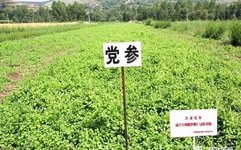Dangshen党参CODONOPSIS RADIX1. 2020 Edition of the Chinese Pharmacopoeia
This product is the dried root of the plant Codonopsis pilosula (Franch.) Nannf., Codonopsis pilosula Nannf. var. modesta (Nannf.) L.T. Shen, or Codonopsis tangshen Oliv. from the family Campanulaceae. It is harvested in autumn, cleaned, and sun-dried.
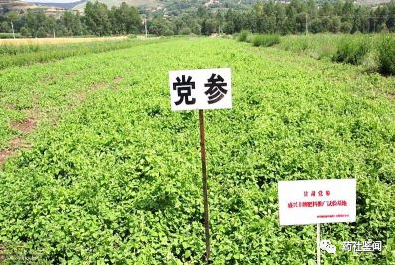
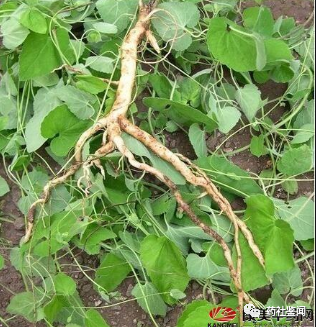
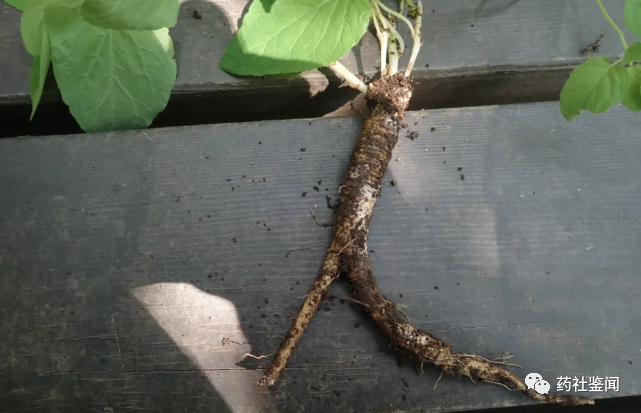
【Characteristics】Dangshen is long cylindrical, slightly curved, 10-35 cm long, and 0.4-2 cm in diameter. The surface is gray-yellow, yellow-brown to gray-brown, with numerous warty protrusions at the root's head and buds; each stem scar has a depressed round dot at the top; below the root head, there are dense annular transverse wrinkles, which gradually become sparse downwards, some reaching half the total length. Cultivated varieties have fewer or no annular transverse wrinkles; the whole has longitudinal wrinkles and scattered transverse long pore-like protrusions, and the broken root often has a black-brown gelatinous substance. The texture is slightly soft or slightly hard with some toughness, the cross-section is slightly flat, with cracks or radial textures, the bark is light brown to yellow-brown, and the wood part is light yellow to yellow. It has a special fragrance and a slightly sweet taste.
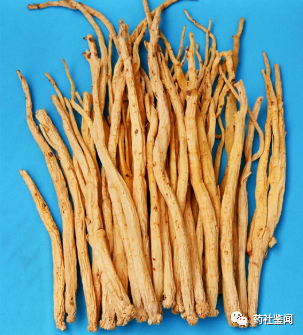
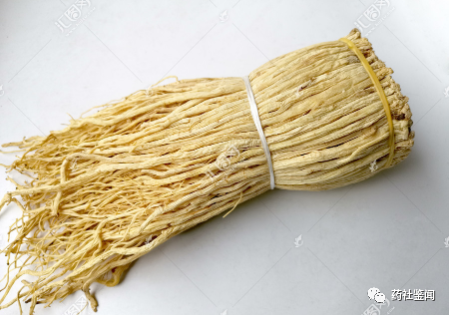
素花党参 (Western Dangshen) is 10-35 cm long and 0.5-2.5 cm in diameter. The surface is yellow-white to gray-yellow, and the dense annular transverse wrinkles below the root head often exceed half the total length. The cross-section has more cracks, with the bark being gray-white to light brown.
川党参 (Chuan Dangshen) is 10-45 cm long and 0.5-2 cm in diameter. The surface is gray-yellow to yellow-brown, with obvious irregular longitudinal grooves. The texture is softer and firmer, with fewer cracks in the cross-section, and the bark is yellow-white.
【Identification】(1) The transverse section of this product shows cork cells in 10 series, with stone cells on the outer side, either singly or in groups. The inner layer of cork is narrow. The phloem is broad, often showing cracks, with scattered light yellow lactiferous tubes, often interspersed with sieve tubes. The cambium forms a ring. The xylem vessels are scattered singly or in groups, arranged radially. Parenchyma cells contain inulin.
(2) Take 1 g of this product powder, add 25 ml of methanol, and sonicate for 30 minutes, filter, evaporate the filtrate, dissolve the residue in 15 ml of water, and pass through a D101 type macroporous adsorption resin column (inner diameter 1.5 cm, column height 10 cm), wash with 50 ml of water, discard the wash, then elute with 50 ml of 50% ethanol, collect the eluent, evaporate, and dissolve the residue in 1 ml of methanol as the test solution. Also, take the dangshen glycoside reference substance, prepare a solution containing 1 mg per 1 ml in methanol as the reference solution. Perform thin-layer chromatography (General Rule 0502) test, applying 2-4 μl of the test solution and 2 μl of the reference solution on the same high-efficiency silica gel G thin-layer plate, using n-butanol-acetic acid-water (7:1:0.5) as the developing agent, develop, remove, dry, spray with 10% ethanol sulfuric acid solution, and heat at 100°C until the spots are clearly colored, then inspect under sunlight and ultraviolet light (365 nm). In the test solution, spots of the same color or fluorescent spots appear at the corresponding positions as in the reference solution.
【Inspection】Moisture must not exceed 16.0% (General Rule 0832, Method 2). Total ash must not exceed 5.0% (General Rule 2302). Residual sulfur dioxide is measured according to the sulfur dioxide residue determination method (General Rule 2331), and must not exceed 400 mg/kg. 【Extractables】Determined by the method for determining alcohol-soluble extractives (General Rule 2201) using hot extraction, with 45% ethanol as the solvent, not less than 55.0%.
2. Chinese Herbal Pieces 【Processing】Dangshen slices: Remove impurities, wash, moisten, cut into thick slices, and dry.
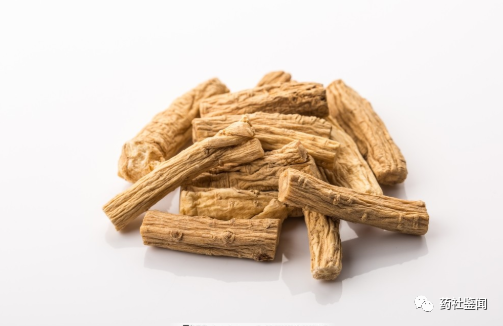
【Characteristics】This product is thick slices resembling round shapes. The outer skin is gray-yellow, yellow-brown to gray-brown, and sometimes the root head has numerous warty protrusions and buds. The cut surface shows the bark as light brown to yellow-brown, and the wood part as light yellow to yellow, with cracks or radial textures. It has a special fragrance and a slightly sweet taste.
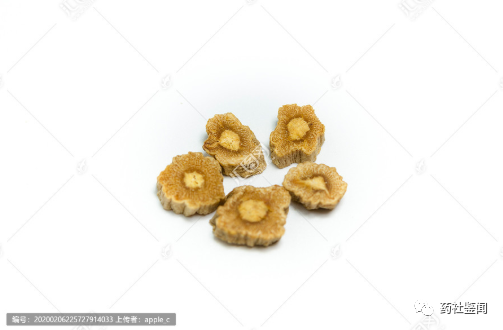
【Identification】【Inspection】【Extractables】Same as the medicinal material. Rice-fried Dangshen: Take Dangshen slices, and stir-fry with rice until the surface is deep yellow, then remove, sift out the rice, and cool. For every 100 kg of Dangshen slices, use 20 kg of rice. 【Characteristics】This product resembles Dangshen slices, with a deep yellow surface, occasionally with scorch marks. 【Inspection】Moisture same as medicinal material, must not exceed 10.0%. 【Identification】【Inspection】 (Total ash, residual sulfur dioxide) 【Extractables】 same as medicinal material.
【Taste and Properties】Sweet, neutral. Enters the Spleen and Lung meridians. 【Functions and Indications】Strengthens the Spleen and benefits the Lung, nourishes blood and generates fluids. Used for Spleen and Lung Qi deficiency, poor appetite, fatigue, cough with shortness of breath, insufficient Qi and blood, pale complexion, palpitations, shortness of breath, thirst due to fluid damage, and internal heat leading to thirst. 【Dosage】9-30 g. 【Cautions】Should not be used with Li Lu (Veratrum). 【Storage】Store in a ventilated and dry place to prevent insect damage.
3. Authenticity Identification 1. Identification of Authentic Dangshen 1) 【Alias】Local names: Lu Dang (common name), Wild Dang (Hebei, Shaanxi), Western Dang (Shaanxi, Gansu), Eastern Dang, Eastern Dangshen, Lion's Head Ginseng, Leaf Vegetable (Northeast), Liao Dang, Three-leaf Vegetable, Leaf Grass (Northeast, Shanxi), Half-section Jar, Middle Spirit Grass, Red Skin Dang, Yellow Dang, Monkey Horse Chicken Skin (Northwest), Ben Dangshen (Liaoning), Tai Dang, Tai Shen, Immortal Grass Root, Du Dang (Hebei), Western Lu Shen, Lu Dangshen (Shanxi), Grass Ginseng (Qinghai), Zhao Shen (Henan), Western Dangshen (Hubei Shennongjia), Hair Dangshen, Vine Dangshen, Vine Ginseng. 2) 【Source】This product is the dried root of the plant Dangshen, Suhua Dangshen, or Chuan Dangshen from the family Campanulaceae. 3) 【Harvesting and Processing】Harvested in autumn, removing the aerial parts and fibrous roots, washing off the soil, sun-drying until semi-dry, repeatedly kneading 3-4 times, bundling into small bunches when 70-80% dry, and then fully drying. 4) 【Origin】Produced in Shanxi, Shaanxi, Gansu, Sichuan provinces, and various regions in Northeast China. Lu Dang (cultivated variety) is produced in Ping Shun, Changzhi, and Huguan in Shanxi. 5) 【Characteristics】Dangshen is long cylindrical, slightly curved, 10-35 cm long, and 0.4-2 cm in diameter. The surface is yellow-brown to gray-brown, with numerous warty protrusions at the root's head and buds; each stem scar has a depressed round dot at the top, known as "Lion's Head"; below the root head, there are dense annular transverse wrinkles, which gradually become sparse downwards, some reaching half the total length. Cultivated varieties have fewer or no annular transverse wrinkles; the whole has longitudinal wrinkles and scattered transverse long pore-like protrusions, and the broken root often has a black-brown gelatinous substance. The texture is slightly hard or slightly tough, with a slightly flat cross-section, cracks or radial textures, the bark is light yellow-white to light brown, and the wood part is light yellow, presenting a "Chrysanthemum Heart" shape. It has a special fragrance and a slightly sweet taste.
Dangshen 素花党参 is 10-35 cm long and 0.5-2.5 cm in diameter. The surface is yellow-white to gray-yellow, and the dense annular transverse wrinkles below the root head often exceed half the total length. The cross-section has more cracks, with the bark being gray-white to light brown. 川党参 (Chuan Dangshen) is 10-45 cm long and 0.5-2 cm in diameter. The surface is gray-yellow to yellow-brown, with obvious irregular longitudinal grooves. The top has fewer transverse wrinkles, and larger pieces may also have "Lion's Head", but with fewer stem scars; smaller pieces have a smaller root head, known as "Mud Eel Head". The texture is softer and firmer, with fewer cracks in the cross-section. The bark is yellow-white, and the wood part is light yellow.
Herbal pieces are gray-yellow to yellow-brown, and the Lion's Head at the root head may be preserved. The cross-section features the bark as yellow-white to light brown, and the wood part as light yellow, with cracks and a Chrysanthemum Heart. It has a special fragrance and a slightly sweet taste.
6) 【Quick Memory】Dangshen is soft, has a gelatinous fragrance and sweet taste, with Lion's Head and Chrysanthemum Heart. (Soft) The texture is soft. (Gel) The broken root has a black-brown gelatinous substance. (Fragrant and Sweet) It has a special fragrance, sweet taste, resembling milk candy. (Lion's Head) The root head has numerous warty protrusions and buds, with each stem scar having a depressed round dot at the top. (Chrysanthemum Heart) The cross-section of the wood part shows radial textures.
2. Counterfeit Products (1) Qin Jiao: Dangshen fibrous roots mixed with Qin Jiao can be distinguished with careful observation. 1) Qin Jiao has many grooves and black skin on the surface; Dangshen fibrous roots only have longitudinal stripes. 2) Qin Jiao has a yellow to yellow-brown cross-section; Dangshen has a light brown bark and light yellow wood core with radial textures. 3) Qin Jiao is hard and bitter; Dangshen is soft and sweet.
Qin Jiao slices
Dangshen fibrous roots
(2) Fang Feng: Cultivated Fang Feng masquerading as Dangshen. Characteristics of cultivated Fang Feng: This product is long cylindrical, 25-40 cm long, and 0.5-1.5 cm in diameter. It may be single or branched at the lower part, with a gray-yellow surface, finer skin, and smaller annular wrinkles at the root head, with visible brown hair-like remnants of leaf bases; the lower part has many deep longitudinal wrinkles, with fewer and denser transverse protrusions. It is relatively solid, hard and brittle, easy to break, with a flat cross-section, the bark is light yellow to brown-yellow, with small cracks, and the wood part is bright yellow. Distinguishing features: 1) Root head: Dangshen has warty protrusions (Lion's Head); cultivated Fang Feng has horizontal annular wrinkles (Earthworm Head) and many hair-like leaf bases. 2) Surface features: Dangshen has horizontal annular wrinkles below the root head, with a black-brown gelatinous substance at the broken root; cultivated Fang Feng has deep longitudinal wrinkles on the surface, without black-brown gelatinous substance. 3) Texture: Dangshen is hard with some toughness; cultivated Fang Feng is hard and brittle, easy to break. 4) Aroma and taste: Dangshen has a special fragrance and sweet taste; cultivated Fang Feng has a distinctly different sweet taste from Dangshen.
Cultivated Fang Feng masquerading as Dangshen
(3) Chuan Ming Shen: Chuan Ming Shen is characterized by a long cylindrical shape, slightly thinner at the lower end, 7-30 cm long, and 0.8-1.2 cm in diameter, thinner than authentic products, with a yellow-brown to light yellow-brown appearance, slightly smooth, with very sparse annular textures, and often has unremoved coarse skin at the depressions; it is hard but not brittle, not easy to break, with a yellow-white cross-section, and several circles of white transparent layered annular textures in the center, slightly white; it has a weak aroma, no taste, and a slightly sweet taste when chewed.
(4) Mi Guo Qing: The dried root of the plant Mi Guo Qing from the family Apiaceae. Produced in Northeast China and other regions. Characteristics: No "Lion's Head"; the root head has scale-like leaf base remnants; has a carrot flavor.
(5) Yang Ru Shen: The dried root and rhizome of the plant Yang Ru from the family Campanulaceae. Characteristics: Spindle-shaped, thick when broken; often has small tumor-like protrusions; light in weight, very porous; the cross-section has no yellow heart; has a spicy taste when chewed.
(6) Gan Zi Dang Shen: The root of the plant Ball-flower Dangshen and Gray-white Leaf Dangshen from the family Campanulaceae. The root of Ball-flower Dangshen is spindle-shaped, with a gradually pointed root head, not presenting a "Lion's Head" shape, light and porous, with a cross-section of milky white bark, having a unique aroma and a faint sweet taste. The root of Gray-white Leaf Dangshen has one or several cylindrical woody remnants at the top of the root head, with a few warty protrusions of the herbaceous stem base remaining on the side.
(7) Chai Dang Shen: The root of the plant Big Flower Money Leopard and Money Leopard from the family Campanulaceae. The root is cylindrical, with edges, slightly curved, with a short root stem at the root head, and branching at the lower part. The surface is gray-yellow, with irregular longitudinal wrinkles and many bump-like protrusions. It is hard, easy to break, with an uneven cross-section, whitish or yellowish-white. It has a weak aroma, a slightly sweet taste, and is gritty when chewed.
(8) Guan Hua Dang Shen: The dried root of the plant Guan Hua Dang Shen from the family Campanulaceae, produced in Yunnan, Guizhou, Sichuan provinces, and some areas use it as Dangshen in medicine, marketed as Bai Dang or Xu Dang. It resembles Dangshen but has fewer or no annular transverse wrinkles, with many irregular longitudinal grooves and ridges, relatively hard texture, white color, weak aroma, slightly sweet taste, and gritty when chewed.
(9) Yin Chai Hu: The dried root of the plant Yin Chai Hu from the family Caryophyllaceae. It has a longitudinal wrinkled appearance, with no annular transverse wrinkles at the root head, and broken roots. The cross-section shows a narrow light brown phloem and a wide yellow-white wood part. The foam test does not produce significant foam (authentic Dangshen produces obvious and lasting foam). How to select high-quality Dangshen.








